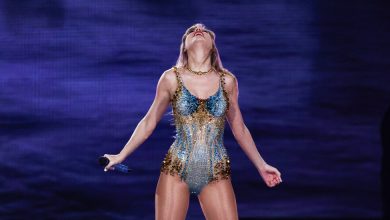The Wandering Creativity of Sophie Taeuber-Arp

There’s an object in the Museum of Modern Art’s retrospective of the Swiss polymath Sophie Taeuber-Arp that’s so covetable I wanted to squeeze it.
It dates from 1922, and takes the form of triangles that lock together into an allover pattern of blue and pink, brown and olive. Interrupting these abstract forms are five red birds, flattened and simplified into icons of a new age. Their wings are jazzily misaligned. Their napes are festooned with triangular plumage as consistent as the teeth of a comb.
This isn’t a painting. It’s a pillow: something beautiful and practical, something new for the eyes but fit for the head.
Modern art, right on your sofa! Opening after a year’s pandemic-obliged delay, “Sophie Taeuber-Arp: Living Abstraction” offers a view of an artist who could not have cared less about the distinctions among the art on your wall, in your living room, on the stage, or on your back. Freewheeling and alive with color, the show puts Taeuber-Arp in her rightful place as a prime mover among the Dadaists of wartime Zurich. It intermingles her abstract watercolors and painted wood sculptures with necklaces, marionettes, beaded purses, stained-glass windows. She could do it all, and was underestimated for decades because of it.
Her multimedia appetite makes her the ideal subject for a blowout in MoMA’s expanded home, where curators now mix painting, photography, design and even cinema into single presentations. The show, exquisite if unbalanced, has arrived here from the Kunstmuseum Basel and Tate Modern in London. It sure is big, with more than 300 objects on loan from 50 collections. Maybe even too big? There are some longueurs in its later galleries, replete with dozens of later abstract paintings and reliefs: so many dancing circles, so many boogieing lines.
It’s also weirdly fainthearted about her art’s sources, notably its clear debts to Native American textiles and African sculpture: influences shared by many of the anarchic rule-breakers of Dada, which plunge her colors and patterns into dialogue with colonialism and ethnography. There’s so much to fancy here, and I bet “Living Abstraction” will sire scads of younger Sophie stans. But might it have done with a little more grit on this score?
She’s never been an obscure figure, exactly. She was a regular at the Cabaret Voltaire, dancing and drinking alongside Tristan Tzara, Hugo Ball, and her future husband, the artist and poet Jean (Hans) Arp. Her face used to be on the 50-franc note in Switzerland, wearing a cloche hat that made her look uncannily like one of her own symmetrical, turned-wood Dada Heads. (She got phased out last decade, replaced on the 50 by some Alps and a dandelion.)
She isn’t even new to MoMA: Taeuber-Arp had a smaller retrospective here back in 1981, and featured in the museum’s 2006 Dada exhibition and 2012 show “Inventing Abstraction.” Too often, though, she’s been relegated to the minor leagues of art history, not only on account of her sex (and her famous husband). For a long stretch of the 20th century, in New York especially, critics and curators maintained that a work of art succeeded most when it fully manifested its “medium specificity,” as the critic Clement Greenberg had it.
Any suggestion that an abstract canvas shared DNA with textiles, furniture design or the “minor arts” was therefore anathema. The biggest insult you could deliver to an abstract painter was that his art — I use the pronoun advisedly — was “decorative.” How could a painting express our highest ideals if it could also provide the pattern for a lady’s handbag?
But there was a whole other strand of modernism, where women were far better represented, that commingled painting and sculpture with the decorative arts. Those obtuse triangles she wove for that must-have pillow appear too in tender gouaches on paper, locking into gray and salmon parallelograms like the teeth of a zipper. A lovely painting that syncopates rectangles of black, red and teal hangs here next to a larger weaving with the same geometric arrangement. The painting obeys the right-angled grid of the loom’s warp and weft. Yet the painting isn’t just a preparation for the tapestry, nor is the tapestry just a translation of the painting.
What Taeuber-Arp saw was that abstract forms could serve as coequal elements in a single creative system. They could be modular, and shape-shifting; forms could migrate at will. Ceiling murals she designed for the Aubette cultural center in Strasbourg have the same gridded structure as her textiles, which themselves echo the grids of the paintings.
And for her this cross-media commitment had an ethical and spiritual dimension. “In our complicated times,” Taeuber-Arp wrote in 1922, “why conceive ornaments and color combinations when there are so many more practical and especially more necessary things to do?” For her the answer lay not outside but inward, in a “deep and primeval urge to make the things we own more beautiful.”
Taeuber-Arp came to this all-media approach right out of her teens, when she left Switzerland to study at one of the most progressive art schools in Europe: the Debschitz School in Munich, where a majority-female student body learned fine and applied arts together. Returning to Zurich in 1914, she established a craft business, began teaching, and also enrolled in dance courses with Rudolf von Laban.
She’d come back to Switzerland to escape the war, and soon a bunch of foreigners did the same. As World War I pulverized any last European claims to civilization, these expat artists turned Zurich into a compression chamber of Western insanity, baptized with the nonsense name Dada. Taeuber-Arp, Dada’s only Swiss member, threw herself into its satirical indictments, above all through the most delightful objects here: loose-limbed, pared-down marionettes from a parodic play, “King Stag,” in the form of courtiers and palace guards, parrots and deer, and kings of the unconscious named Freudanalyticus and Dr. Oedipus Complex.
The marionettes are wonderful relics of Dada diversions. They are also sculptures, self-evidently inspired by the stylized geometric forms of Central African statuary — as are the rounded Dada Heads, her substitute self-portraits, which appear like Congolese or Gabonese masks rotated around a central axis. There’s not a word in any wall text here about Africa or Indigenous America (as well as Swiss folk art, another influence); from the title on, MoMA focuses on abstraction above all. Yet as I moved forward, the show’s indifference to her cross-cultural influences started to feel more like a conspiracy of silence than a choice of emphasis.
Only one photograph survives of Taeuber-Arp dancing, wearing a geometric mask at one of many Dada wild nights where Europeans chanted in fake African languages and performed bogus tribal dances. The curators call the mask “Cubist-inspired,” and bury the photo on a four-inch card hung below eye level.
Taeuber-Arp’s ornamented necklaces strongly recall Zulu beadwork; fringed textiles share the color schemes and geometric patterns with those of the southwest United States; this all passes without notice. The silence gets weirder when you consider that Walburga Krupp, one of the curators of MoMA’s current show, scrutinized Taeuber-Arp’s passion for Native American textiles in the catalog of “Dada Africa,” a rigorous exhibition of Dada and non-Western art seen in Zurich, Berlin and Paris in 2016-17. (The other curators here are Anne Umland of MoMA, Eva Reifert of Basel, and Natalia Sidlina of the Tate.)
Indeed, some of Taeuber-Arp’s most widely known works before this show were costumes whose geometric patterns she modeled after Hopi katsina dolls — ones that Carl Jung, her fellow Swiss, bought on a trip to New Mexico. The costumes appear on the cover of the “Dada Africa” catalog; one was on display just this summer in “Women in Abstraction,” at the Centre Pompidou. But they’re not here in New York, nor in MoMA’s publication. Only the most attentive reader will find, buried in footnotes, a disclosure that the garments “have been omitted from this publication out of respect for the Hopi and Pueblo peoples.”
Forgive me, I’m really not one for cancel-culture bromides, but we’re in serious trouble if our leading museum of modern and contemporary art thinks it’s necessary to hide the colonial inspirations of European art from its visitors — or, worse, thinks its visitors aren’t sophisticated enough to recognize them. (The images are already widely published; Hopi art lovers have Google, too.) Umland, the MoMA curator, told me that the pseudo-Hopi textiles were “not essential to the thesis of the exhibition,” even as she conceded that “the important reason stated in the catalog” weighed on their decision too.
I wonder. The abstract impulse that Taeuber-Arp brought to her art and life wasn’t only about color and line. Her “deep and primeval urge” proceeded straight through colonial anthropology and ethnography. Instead of hushing that up or standing in judgment, why not analyze it, historically, with all the intellectual tools these Europeans didn’t have and voices they couldn’t hear? Nearly 40 years after its notorious exhibition on “primitive” art and its modernist influence, has MoMA really not come up with a better approach to this period than concealment?
As it is this show is almost too beautiful, and in its later stretches we encounter acres of refined abstractions that the artist painted in France in the 1930s, saturated with floating circles, rectangles, squiggles and half-moons. When war came a second time, and canvases became harder to procure, she made smaller but no less ambitious drawings, where sidewinding squiggles face off with hard-edged angles. Back in Switzerland in 1943 she stayed for the night at her friend Max Bill’s house; she lit a fire in the guest bedroom, failing to notice the stove’s flue was closed, and never woke up. She was 53.
The density of crosses and curves has a clear aim. They’re here in force to establish the artist as a modernist of the first importance — a modernist of MoMA caliber. In this “Living Abstraction” succeeds totally, and Sophie Taeuber-Arp seems almost a self-contained paradigm of this museum’s recent reinvention: an artist who could make abstraction into a high calling, in fine and applied arts equally. She also has her place in a more global museum, where pictures and people shuttle through endless encounters and no abstraction is pure.
Sophie Taeuber-Arp: Living Abstraction
Through March 12 at the Museum of Modern Art, 11 West 53 Street, Manhattan; 212-708-9400, moma.org.




